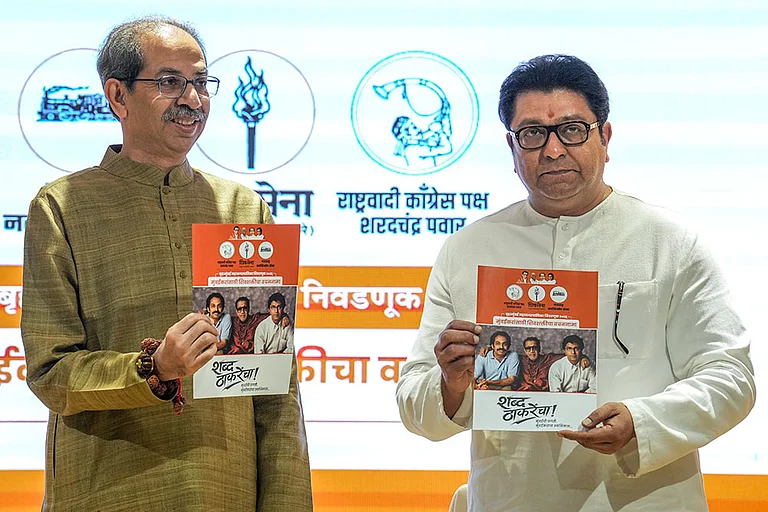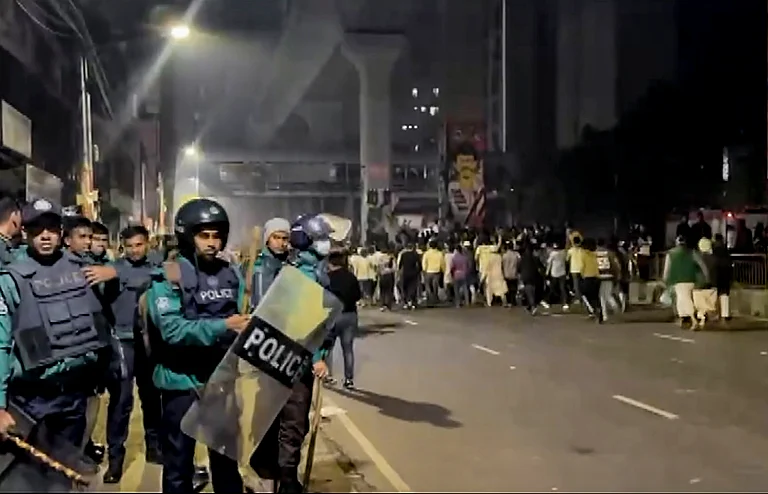Maharashtra government on Monday, September 23, approved a proposal to name to name Pune airport as Jagadguru Sant Tukaram Maharaj Pune International Airport after a cabinet meeting. This comes weeks after the central government announced that Port Blair in Andaman and Nicobar Islands has been renamed Sri Vijaya Puram to erase colonial imprints.
Earlier this month, seers in Uttarakhand, a state known for its Hindu pilgrimage sites, expressed concerns about the use of Urdu words like "shahi" in Hindu religious texts that are read out in ceremonies and titles. The term, which means "royal" in Urdu, has been widely used in Indian cultural and religious contexts for centuries. However, the seers argued that it is time to revert to words that reflect India’s indigenous linguistic heritage.
Seers of the the holy city of Haridwar in Uttarakhand on September 5 pitched for removal of Urdu words like 'shahi' used in Hindu religious contexts and suggested replacing them with their Hindi or Sanskrit substitutes.
This recent name changes and pitches like the one mentioned above come at a time when renaming places, symbols, and institutions associated with colonialism, Mughal rule, or perceived foreign influence has gained momentum under the current Prime Minister Narendra Modi-led government.
Pune Airport, Port Blair Renamed
On September 13, the central government announced it has decided to rename the capital of Andaman and Nicobar Islands Port Blair as "Sri Vijaya Puram”. In a post on ‘X’, Home Minister Amit Shah said the decision was taken inspired by the vision of Prime Minister Narendra Modi, to free the nation from the "colonial imprints".
The Home Minister said that while the earlier name had a colonial legacy, Sri Vijaya Puram symbolises the victory achieved in our freedom struggle and the A&N Islands' unique role in the same.
Maharashtra government on September 23 approved a proposal to name to name Pune airport as Jagadguru Sant Tukaram Maharaj Pune International Airport. The decision was taken at a state cabinet meeting, an official said, adding the proposal will be sent to the Centre.
The state cabinet approved the proposal by Union Minister of State for Civil Aviation Murlidhar Mohol, who hails from Pune, for renaming the airport. Sant Tukaram was a prominent saint and spiritual poet during the Bhakti movement. He was born in Pune district.
Call For Removal Of 'Shahi'
The demand in Uttarakhand has cropped up after Madhya Pradesh Chief Minister Mohan Yadav, while referring to the Lord Mahakal procession in Ujjain recently, used 'Rajasi Sawari' instead of 'Shahi Sawari'.
The seers said that a meeting of the various Akharas will soon be convened here to pass a resolution seeking the replacement of words like 'shahi' or 'peshwai' with their Sanskrit substitutes.
According to them, these words are symbolic of India's slavery to the Mughals.
'Shahi' is often used in the context of Kumbh congregation in which royal bath is referred to as 'Shahi Snan'. Supporting the Madhya Pradesh CM, the Akhil Bharatiya Akhada Parishad -- the highest body of saints -- said that the word 'shahi' is not in the tradition of Indian culture.
"Words like shahi and peshwai are symbols of slavery and were used by the Mughal rulers to show their pride. These words are from the Urdu language, whereas the language of ancient Indian Sanatan culture is Sanskrit from which Hindi has originated," news agency PTI quoted Akhil Bharatiya Akhada Parishad president Mahant Ravindra Puri (Niranjani) as saying.
Words like 'rajasi' were used in ancient times for 'shahi' or royal, he said.
Puri said a meeting of the Akharas will soon be called to discuss the matter and pass a resolution replacing the Urdu words used in Hindu religious contexts with Sanskrit-origin words. The resolution will be sent to the administration of all cities where the Kumbh fair or similar religious congregations are held.
The development brings focus back on the renaming spree Under the Narendra Modi government, which came back to power for the third straight time after winning the Lok Sabha elections this year.
Big Renaming Decisions Of Modi Govt
The Modi government has taken several high-profile renaming decisions over the past few years, targeting cities, railway stations, roads, and even official buildings. The renaming efforts are often positioned as part of a larger push for "decolonisation" and restoration of India’s historical identity.
Some of the key renaming initiatives include:
Allahabad to Prayagraj: Perhaps one of the most iconic renaming acts of the Bharatiya Janata Party (BJP-led National Democratic Alliance (NDA) government of PM Modi, the ancient city of Allahabad was renamed Prayagraj in 2018. This move was seen as restoring the original name of the city, which is associated with the Triveni Sangam, the confluence of three sacred rivers in Hinduism.
ALSO READ | Amrit Udyan To Kartavya Path: Prominent Places That Were Renamed Under Modi Rule
BJP leaders and party supporters took up the issue claiming that the city's original name was Prayag, which means "place of offerings" in Sanskrit. The name is believed to have come from the city's location at the Sangam of the Ganga and Yamuna rivers, and the mythical Saraswati river.
It is said, Mughal emperor Akbar in the late 16th century built a fort near the confluence of the Ganga and Yamuna rivers and named it "Ilahabad". His grandson Shah Jahan later renamed the entire city "Allahabad".
Uttar Pradesh Chief Minister Yogi Adityanath said the name change was made because "Prayag is where Lord Brahma performed the first yagna (ritual sacrifice)". He also said that the confluence of two rivers is a “prayag” and that Allahabad is the “king of 'prayags'”.
Mughal Gardens to Amrit Udyan: In 2023, the renowned Mughal Gardens at Rashtrapati Bhavan in New Delhi were rechristened as "Amrit Udyan." This decision came as part of the "Azadi ka Amrit Mahotsav" celebrations and was seen as an attempt to align the name with the spirit of Indian independence.

Rajpath To Kartavya Path: The iconic ceremonial boulevard in Delhi called Rajpath was redeveloped under Central Vista Redevelopment Project and renamed 'Kartavya Path', a move that was criticised by the Opposition saying it was "pure politics".
Once known as 'Kingsway' during the British rule, Rajpath referred to the ceremonial boulevard in Lutyens Delhi that runs from Rashtrapati Bhavan on Raisina Hill through Vijay Chowk and India Gate, National War Memorial to National Stadium, Delhi.

The move came ahead of the inauguration of the revamped Central Vista Avenue, part of the Modi government's pet Central Vista project to give a makeover to the Raisina Hills area, constituting the country's main administrative block in the capital.
Aurangzeb Road to Dr. APJ Abdul Kalam Road: In 2015, Aurangzeb Road, named after the controversial Mughal emperor, was renamed after former President Dr APJ Abdul Kalam. The decision was praised by many who saw it as a fitting tribute to former President and one of India’s most beloved leaders.
Rashtrapati Bhavan Halls: In July this year, Rashtrapati Bhavan's 'Durbar Hall' and 'Ashok Hall' were officially renamed 'Ganatantra Mandap' and 'Ashok Mandap', respectively. The Durbar Hall of Rashtrapati Bhavan hosts Civil and Defence Investiture Ceremonies, during which the President of India confers prestigious honours on the recipients.
The Ashok Hall, which originally was a ballroom, is used for presentation of credentials by Heads of Missions of foreign countries and as a formal place of introductions for the visiting and Indian delegations prior to the commencement of the State Banquets hosted by the President.
Faizabad to Ayodhya: In another significant move, the city of Faizabad was renamed Ayodhya in 2018, in reference to the birthplace of Lord Ram, a revered figure in Hinduism.
Renaming Not Uncommon In India, But...
The renaming of places is not unique to the current government. India's post-independence history has seen multiple renaming campaigns aimed at shedding colonial legacies.
For instance, Bombay was renamed Mumbai, Madras became Chennai, and Calcutta was changed to Kolkata.
However, the current wave of renaming, particularly targeting Mughal and Persian influences, marks a shift in focus towards pre-colonial, especially ancient Hindu, history.


























